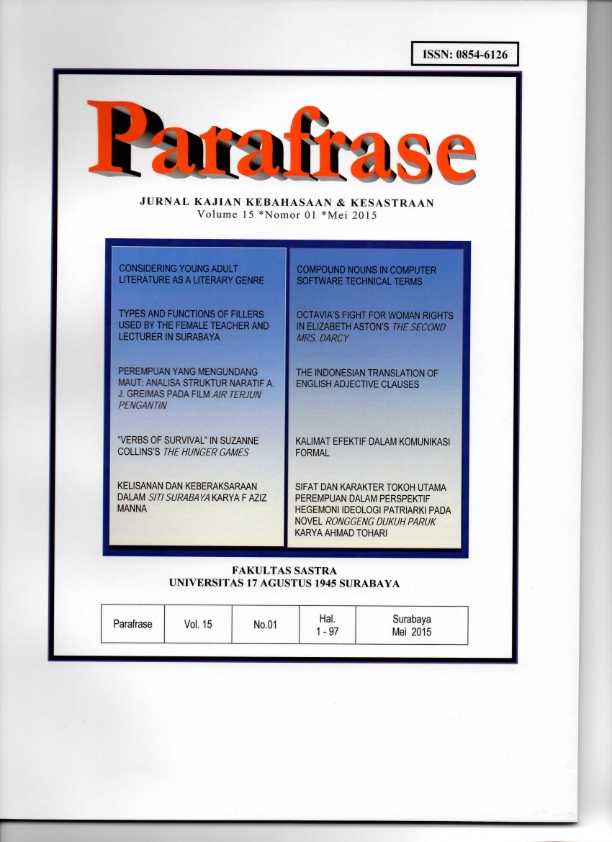OCTAVIA’S FIGHT FOR WOMAN RIGHTS IN ELIZABETH ASTON’S THE SECOND MRS. DARCY
Abstract
Abstract. Makalah ini melaporkan studi tentang perjuangan seorang tokoh perempuan untuk memperoleh hak kesetaraan. Studi ini membahas perjuangan tokoh utama, seorang perempuan bernama Octavia, dalam novel karya Elizabeth Aston yang berjudul The Second Mrs Darcy, dalam mengatasi masalah ketidaksetaraan secara ekonomis, politis, sosial maupun psikologis. Pertanyaan yang diajukan adalah apakah usaha-usaha tokoh perempuan dalam novel The Second Mrs. Darcy dalam memperjuangkan hak kesetaraan dengan laki-laki. Penelitian menggunakan metode deskriptif, dengan novel The Second Mrs. Darcy sebagai sumber data utama, dengan data berupa kata, frasa dan kalimat dalam novel tersebut. Penelitian ini juga menggunakan pendekatan intrinsik (berfokus pada karakter dan setting) dan ekstrinsik (berfokus pada tradisi dan nilai-nilai dalam struktur sosial yang digambarkan dalam novel). Hasil penelitian menunjukkan bahwa Aston membahas masalah kedudukan perempuan dan ketaksetaraan gender khususnya terutama dalam hak di depan hukum dan hak berbicara. Penelitian menunjukkan bahwa perjuangan yang dilakukan oleh tokoh utama Octavia meliputi hak bekerja, hak atas pemilikan harta benda, hak mendapat perlakuan adil dan emansipasi dan hak bicara dan menyampaikan pendapat.
Â
Keywords: character analysis, fight for woman rights
Downloads
References
Abrams, M. H. 1999. A Glossary of Literature Terms. Seventh Edition. United States of America: Heinle & Heinle, Thomson Learning, Inc.
Abrams, Lynn. 2001. Ideal of Woman in Victorian Britain. (accessed 24 June 2013). <http://www.bbc.co.uk/history/trail/victorianbritain/women/idealswomanhood09.html>
Aston, Elizabeth. 2007. The Second Mrs. Darcy. New York: Touchstone.
Blaxter, L., Hughes, C. and Tight, M. 1996. How to Research. Buckingham: Open University Press.
Cixous, H. and Clément, C. 1986. “The Newly Born Womanâ€, trans. Betsy Wang. Theory and History of Literature. Volume 24. Minneapolis: University of Minnesota Press.
Combs, Mary Beth. 2005. “A Measure of Legal Independence": The 1870 Married Women's Property Act and the Portfolio Allocations of British Wives†The Journal of Economic History Volume 65. No.4 . (accessed 21 February 2013). <http://en.wikipedia.org/wiki/ Married Women’s Property Act 1870>
International Labour Organization (ILO). 2000. ABC of Women Workers’ Rights and Gender Equality. Geneva 22: Switzerland.
Kenny, William. 1996. How To Analyze Fiction. New York: Monarch Press.
Levi, Leone. 1863. International commercial law being the principles of mercantile law of the following and other countries. London: V. and R. Stevens, Sons, and Haynes.
Meyers, Michael. 1990. The Bedford’s Introduction to Literature. Boston: St. Martin’s Press.
Nelson, Claudia. 2007. Family Ties In Victorian England. United States of America: Westport, Connecticut London.
Ruffcor, R. E. “Liberal Feminism,†Summary of Feminist Thought. (Fall 01 December 2002)
Tyson, Lois. 2006. Critical Theory Today. Second Edition. New York: Routlege, Taylor and Francis Group.
UNM-New Mexico’s Flagship University. Elements of Fiction. (accessed 04 January 2013). < http://www.unm.edu/~hookster/Elements of Fiction.pdf >.
Powell, Jim. “Marry Wollstone-Equal Right for Womenâ€. The Freeman Journal. (Fall 01 April 1996)
Victoria and Albert Museum. Gender Ideology and Separate Spheres in the 19th Century: Gender and Power. (accessed 30 April 2013). <http://www.vam.ac.uk/content/articles/g/ gender-ideology-and-seperate-spheres-19th-century/>
Wellek, R. and A. Warren. 1956. Theory of Literature. USA: Harcourt, Brace & World, Inc.
Tong, Rosemarie Putnam. 1998. Feminist Thought: A More Comprehensive Introduction. Boulder: Westview Press.
Authors publishing in the Journal will be asked to sign a Copyright Assignment Form. In signing the form, it is assumed that authors have obtained permission to use any copyrighted or previously published material. All authors must read and agree to the conditions outlined in the form, and must sign the form or agree that the corresponding author can sign on their behalf. Articles cannot be published until a signed form has been received.It is a condition of publication that authors assign copyright or license the publication rights in their articles, including abstracts, to email jurnalparafrase@untag-sby.ac.id. . This enables us to ensure full copyright protection and to disseminate the article, and of course the Journal to the widest possible readership in print and electronic formats as appropriate.
















